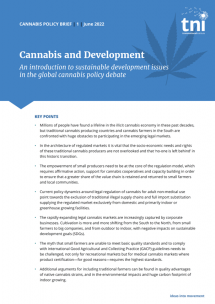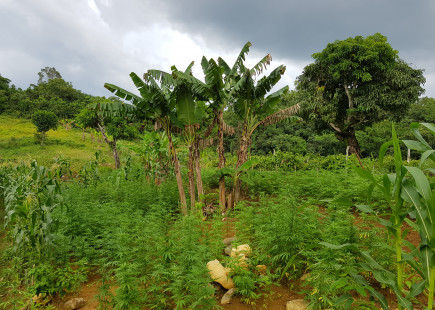Cannabis and Development An introduction to sustainable development issues in the global cannabis policy debate
Temas
Millions of people have found a lifeline in the illicit cannabis economy in these past decades, but traditional cannabis farmers in the South are confronted with huge obstacles to participating in the emerging legal markets. The rapidly expanding legal cannabis markets for medical and adult use are increasingly captured by corporate businesses. Cultivation is more and more shifting from the South to the North, from small farmers to big companies, and from outdoor to indoor, with negative impacts on sustainable development goals. This first TNI Cannabis Policy Brief argues that it is vital that the socio-economic needs and rights of traditional cannabis producers are not overlooked and that ‘no-one is left behind’ in this historic transition.

Descargas
-
Cannabis and Development (PDF, 262.92 KB)Tiempo medio de lectura: 10 minutes minutos*
-
Cannabis und Entwicklungspolitik (Deutsch) (PDF, 270.85 KB)Tiempo medio de lectura: 10 Minuten minutos*
Autores

Cannabis cultivation, Jamaica, 2019, TNI/Martin Jelsma
Key points
- Millions of people have found a lifeline in the illicit cannabis economy in these past decades, but traditional cannabis producing countries and cannabis farmers in the South are confronted with huge obstacles to participating in the emerging legal markets.
- In the architecture of regulated markets it is vital that the socio-economic needs and rights of these traditional cannabis producers are not overlooked and that ‘no-one is left behind’ in this historic transition.
- The empowerment of small producers need to be at the core of the regulation model, which requires affirmative action, support for cannabis cooperatives and capacity building in order to ensure that a greater share of the value chain is retained and returned to small farmers and local communities.
- Current policy dynamics around legal regulation of cannabis for adult non-medical use point towards the exclusion of traditional illegal supply chains and full import substitution supplying the regulated market exclusively from domestic and primarily indoor or greenhouse growing facilities.
- The rapidly expanding legal cannabis markets are increasingly captured by corporate businesses. Cultivation is more and more shifting from the South to the North, from small farmers to big companies, and from outdoor to indoor, with negative impacts on sustainable development goals (SDGs).
- The myth that small farmers are unable to meet basic quality standards and to comply with international Good Agricultural and Collecting Practice (GACP) guidelines needs to be challenged, not only for recreational markets but for medical cannabis markets where product certification―for good reasons―requires the highest standards.
- Additional arguments for including traditional farmers can be found in quality advantages of native cannabis strains, and in the environmental impacts and huge carbon footprint of indoor growing.


